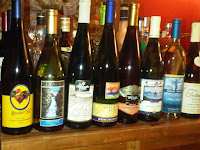Apparently this is a popular grape among the Finger Lakes wineries and is becoming just as prevalent as Riesling. This is perhaps a bit of an over-statement, but a guess of 50 producers in the region was thrown out. It is produced in all lakes, and I asked the winemakers if there are any lake-induced differences. The consensus was that there is a difference between wineries - as is the case with Riesling - but this difference results more from production methods and not "terrior". And these production methods create both dry and semi-dry versions.
- Dr. Frank's Vinifera Wine Cellars 2011 Gruner Veltliner
- Glenora Wine Cellars 2011 Pinot Blanc
- King Ferry Winery 2010 Reserve Chardonnay Cayuga Lake
- Goose Watch Winery 2011 Pinot Grigio
- Sheldrake Point Winery 2011 Gewurztraminer
- Seneca Shore Wine Cellars 2010 Dry Gewurztraminer
- Rooster Hill Vineyards 2010 Estate Gewurztraminer
- Wagner Vineyards 2010 Gewurztraminer Semi-Dry
Started with the dry, the grapes for the Sheldrake Point Winery 2011 Gewurztraminer were not harvested until mid-October. This allowed the fruit to gain traction and the final product is balanced with nice acidity. The aroma falsely imply sweetness, but there's actually only 0.4% rs.
Vibrant yellow gold in color, with a sensuous and silky weave of acid and mineral on the palate. Flowered perfume of rose and passion fruit flow to silky red grapefruit on the finish. – Winemaker’s Notes
The grapes for the Seneca Shore Wine Cellars 2010 Dry Gewurztraminer were harvested a full month earlier and made to a similar 0.43% rs; but is a completely different wine. It portrays more of the grape's inherent spiciness.
This big, unctuous and full bodied white wine has a thick, creamy texture and fruit galore. The nose is reminiscent of fresh tea roses with a palate filled with juicy lycee fruit, finished with spicy pepper. – Winemaker’s Notes
Moving to the semi-dry styles, Gewurztraminer contains enough acids to balance this style. The Rooster Hill Vineyards 2010 Estate Gewurztraminer was my favorite gewurz for the evening. It is produced from a single vineyard - Catherine Vineyard - on the east side of Keuka Lake. Even with 1.8% rs, this is a refreshing wine, lycee flavors and spice. Very nice.
This single vineyard Gewurztraminer from the Catherine Vineyard is aromatic with soft, pretty rose petal, accented by hints of citrus, grass and Asian spice. A bright and refreshing wine with a delicate spicy finish. – Winemaker’s Notes
The Wagner Vineyards 2010 Gewurztraminer Semi-Dry contains similar sugar levels (1.75%) and the grapes were grown surrounding Seneca Lake. This wine also portrays how extra sweetness imparts more flavors than the dry versions; with enough acid to generate a balanced mouth feel.
A mouthfilling wine, full of spicy fruit flavors & an orange blossom bouquet. – Winemaker’s NotesIt's time to plan a trip to the Finger Lakes Wine Country. There is a diverse wine world that we need to check out. And here's the link to the recorded live stream. Cheers.
http://www.ustream.tv/channel/finger-lakes-wine-virtual-tasting-series









